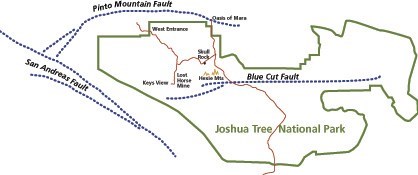
Joshua Tree is crisscrossed with hundreds of faults, and it is a great place to see raw rocks and the effects of earthquakes. The famous San Andreas Fault bounds the south side of the park and can be observed from Keys View. Blue Cut Fault in the center of the park can be seen from the hilltop behind Lost Horse Mine. This fault forms the straight, abrupt base of the Hexie Mountains east of Queen Valley. Fault zones are important factors in localizing natural springs. Movement on faults breaks and shatters rocks, forming impervious zones of very fine rock particles along the fault. This material does not allow water to flow through it, so these zones form underground dams, forcing groundwater to rise. The Oasis of Mara at the visitor center in Twentynine Palms marks the Pinto Mountain Fault. The park has four other fault-caused oases that support the native palm tree, Washingtonia filifera. These oases supply food and water to a wide variety of wildlife and point to the connection between the park's geology and its wildlife habitat. Will Joshua Tree National Park experience a large earthquake anytime soon? Despite a great amount of recent seismic research, no one can yet predict earthquakes with any accuracy. The earth will continue to shake in Southern California, and most earthquakes will be small: detected by seismographs, but rarely felt by people. Occasionally, a larger one will occur, but when or where remains unknown. |
Last updated: December 20, 2020
